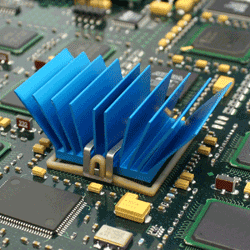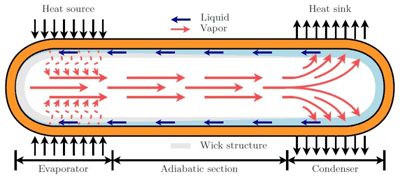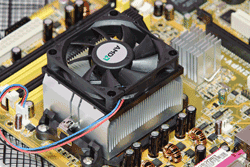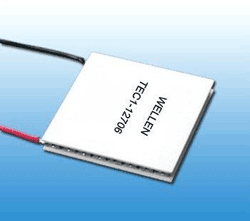Fundamentals of active vs. passive thermal management
Thermal technologies give designers a wide variety of options to keep electronics cool
BY MICHAEL J. KAWA
Managing the heat generated by components has always been an important element of electronic design. It is even more true today as power densities continue to increase and individual components such as microprocessors continue to draw more power to meet the demanding functional and computational requirements of current high powered applications.
Not surprisingly, the combination of higher powered components and more densely populated circuit boards are creating systems which also generate more heat than ever before. This brackets up the challenge of implementing effective thermal design since the main cause of electronic failure is heat.
When components operate at excessive temperatures or are exposed to high localized temperatures, their functionality and operational life can be severely compromised. Prolonged operation in these conditions will ultimately lead to component degradation and failure.
To ensure proper performance and reliability, the excess heat must be transported away from critical components and system hot spots, and then dissipated into the ambient environment. This cooling process can be accomplished by applying the three fundamental methods of heat transfer from which all thermal solutions derive; conduction, convection, and radiation.
• Conduction is the process by which heat flows from an area of higher temperature to one of lower temperature within a single medium – solid, liquid or gas – in an attempt to equalize thermal differences. It is also used to describe heat transfer between media that are in direct physical contact such as two touching solids.
• Convection is the transfer of heat between a solid surface and a fluid (gas or liquid) due to the bulk motion of the fluid. In the case of natural convection, ambient air absorbs heat from a nearby heated surface. It becomes warmer than the surrounding air and rises. Cooler air replaces the warmer air and a natural flow occurs.
• Radiation heat transfer results when thermal energy in the form of electromagnetic waves is emitted from a body due to its temperature. Emission and absorption is determined by the temperature and surface condition of the radiating source, and the temperature of the surrounding environment.
Conduction and convection are the primary modes of heat transfer in electronic design with radiation typically removing only a small portion of the overall thermal load. The effectiveness of managing heat is determined by how well the heat transfer mechanisms are integrated into each level of electronic packaging. This includes the component, board and system levels. While there are many different thermal devices and design strategies which can be used, they generally fall into two categories – passive or active.
Passive thermal management
Passive thermal management refers to cooling technologies that rely solely on the thermo-dynamics of conduction, convection and radiation to complete the heat transfer process. These technologies are the most commonly used, the least expensive and the easiest to implement.
Heat sinks
The most frequently employed passive cooling device is the heat sink. It is a mass of thermally conductive metal such as aluminum or copper which is physically mounted to a heat generating component. Heat is transferred from the component to the heat sink through conduction and then dissipated through the heat sink's surface into the ambient air through natural convection.
The larger thermal mass provided by heat sinks enable them to dissipate more heat than a component would on its own. Their heat transfer ability is further enhanced by adding fin-like structures to the base, increasing the overall surface area available for convection and radiation.

Fig. 1: The maxiFLOW heat sink design from Advanced Thermal Solutions features a spread fin array that maximizes surface area for more effective air convection cooling.
Heat spreaders
Another often used cooling device is a heat spreader. It is a thermally conductive metal plate or foil which is used to move concentrated heat and distribute it over a wider area. It is normally used as an intermediate thermal interface between a heat source and a secondary heat exchanger such as a heat sink.
Heat spreaders are often applied as a backing plate to printed circuit boards (PCBs) containing heat generating components. Thermal vias are placed in the PCB which act as thermal conduits between each component package and the heat spreader to improve heat flow. Some PCB technologies eliminate the need for an external plate by integrating a metal core layer directly into the board which allows the PCB itself to act as a heat spreader.
Heat pipes
An extremely efficient method of thermal conduction is provided by heat pipes. These devices consist of a sealed, hollow tube containing a liquid or coolant. One end of the tube is attached to a heat source and the other end to a secondary heat exchanger such as a heat sink.
Heat generated from a component boils the liquid at one end of the pipe which then travels to the cool end. The vapor condenses (giving off latent heat) and returns back to the heated end through capillary action or gravity. Heat pipes are typically made of a thermally conductive metal which can be flat or bent into complex shapes which make them very suitable for space limited board designs.

Fig. 2: Heat transfer using heat pipes. (Graphic courtesy of the Dutch Knowledge Center for heat pipe technology.)
Thermal interface materials (TIMs)
An important means of optimizing the heat transfer between a heat source and a cooling device (or between two adjacent cooling devices) is the use of TIMs. They are thermally conductive, pre-manufactured materials which can be applied in a variety of forms. These include thermal pads, adhesives, gels and grease.
TIMs are designed to conform to surface irregularities and imperfections which allow them to fill in air gaps between contact surfaces. This ensures that the maximum available surface area is being used for heat transfer.
Active thermal management
Active thermal management refers to cooling technologies that must introduce energy – typically from an external device – to augment the heat transfer process. A key benefit is that they increase the rate of fluid flow during convection which dramatically increases the rate of heat removal. Their drawbacks include the need to use electricity in order to operate, the possible introduction of audible noise to a system, and the fact that they are generally more complex and expensive than passive systems.
Forced air
The most common method of active cooling is the application of forced air over a heat source. This is accomplished by using a fan or blower to increase the flow of air directly above a heat generating component or a passive cooling device such as a heat sink. The increased air flow moves heated air away at a faster rate which significantly improves the overall heat dissipation.
Fans of different sizes and configurations can be used to control flow rate while the flow path can be optimized by their proper placement and orientation. This is especially important in enclosed systems where heated air must be channeled to an exhaust vent. More complex systems utilize electronic fan control to manage both variables based on feedback from localized temperature sensors.

Fig. 3: A fan/heat sink assembly from AMD provides forced air convection to cool a CPU.
Forced liquid
Another type of active heat management is pumped liquid cooling. This closed loop system consists of a circulating liquid coolant moved by a pump through discreet tubing to remove heat from a heat source. In electronic cooling, the most common application of this technology is cold plates.
A cold plate is a thermally conductive metal containing internal channels or embedded tubing which allows liquid coolant flow. The device is typically mounted to the back of a PCB containing heat generating components. The heat source heats up the liquid coolant inside the cold plate which is pumped to a secondary heat exchanger where it is cooled. The cooled liquid is then returned to the cold plate where the heat transfer cycle repeats.
Solid-state heat pumps
These semiconductor devices are often referred to as thermoelectric coolers (TECs). They are thin and compact, and typically placed between a heat source and a heat sink to facilitate quicker heat dissipation. When a voltage is applied to a TEC, a temperature differential is formed between the two sides of the device. This enables heat transfer to occur through conduction.

Fig. 4: A solid-state heat pump from Wellen Technology.
While TECs are not very efficient, they still move substantial amounts of heat and have a very long service life. They are ideal for applications requiring spot cooling or where sub-ambient temperatures are required. In addition, if current is reversed on a TEC, the heat transfer flow reverses. This essentially turns the device into a heater which can be ideal for applications where precise temperature control is needed. ■
Advertisement
Learn more about Electronic Products Magazine





